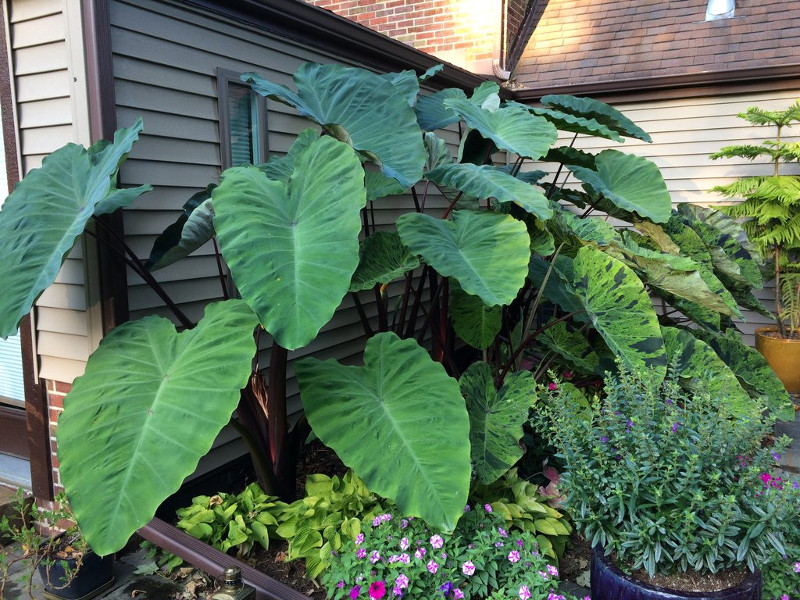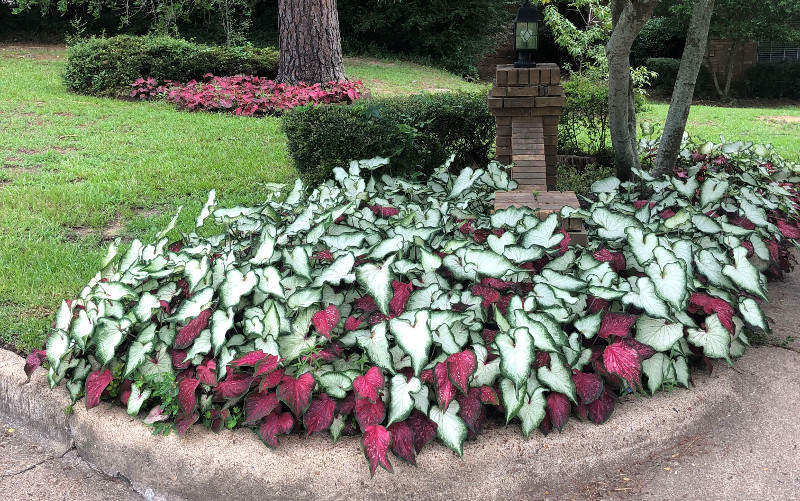Elephant Ear is a genus of flowering plants in the family Araceae, native to southeastern Asia and the Indian subcontinent. Elephant Ear is also known as Colocasia or Caladium. Though related, the plants have different growing preferences. Many Colocasia like soggy soil and tropical conditions. Caladiums like humidity and average water, but do not fare well in wet soil. Hardy in USDA zones 8-11, this plant likes full sun to partial shade.
Elephant Ear is a showy exotic plant with huge heart- or arrow-shaped leaves. Growing 3-8 feet tall with a similar spread, gardeners love this plant to add a tropical feel to patios and balconies. It is perfect for containers, mass planting, and focal points.

Planting Elephant Ears
Typically, Elephant Ears are planted in the spring, but can be planted into early summer as well. This fast grower will reach its full size within two months. Choose a location that will get full sun to partial shade and not too much wind. Mix in manure or compost into the soil. Dig a hole 2-4 times larger than the tuber. Elephant Ears grow best planted close to the surface, so do not plant it too deep.
This plant likes wet soil and is perfect if planted in boggy areas or around water gardens.

Watering Elephant Ears
Elephant Ear is also known as Colocasia or Caladium. Though related, the plants have different growing preferences. Many Colocasia like soggy soil and tropical conditions. Caladiums like humidity and average water, but do not fare well in wet soil. Pay attention to the variety that you purchase.
Keep Elephant Ear plants consistently moist. This plant will quickly die off in dry soil. Plan on giving your Elephant Ear 2-3 inches of water each week.
Fertilizing Elephant Ears
Because an Elephant Ears is a large-leaved tropical plant, it is a heavy feeder. Beginning in the spring and into the fall, apply fertilizer each month. Use a water soluble balanced fertilizer such as 10-10-10 or 20-20-20. To achieve rich dark colored foliage, use Epsom Salts monthly. Add 1 tablespoon of salts to a gallon of water and spray the foliage
Pruning Elephant Ears
Elephant Ear plants have a fast growth rate and can easily become overgrown. Regular pruning will help to keep this large leaf plant in shape. The leaves will naturally droop as they age. Drooping leaves can be cut off with a sharp blade. Yellowing or brown leaves can be cut off at the stem. Disinfect the blade with each cut to prevent the spread of disease. This will give the plant more energy to put towards new growing leaves.
Caring For Elephant Ears in Pots
Elephant Ear plants thrive in containers as long as you give them the right growing conditions. Plant them in an extra large pot with drainage holes to give the roots room to grow. This also allows the soil to dry out slower, as the plant likes consistently moist soil. Plant Elephant Ears in potting soil mixed with compost. Fertilize once a month as they are heavy feeders. Elephant Ear plants can be overwintered by placing them in a cool basement, or porch.

Winter Care for Elephant Ears
In warmer climates, Elephant Ears can be left outdoors year-round. In colder climates, they are usually discarded at the end of the growing season. After the first frost, the tubulars can be dug up and stored indoors until replanting the next spring. Another option is to bring the container plant indoors to grow during the winter.
Remember, Elephant Ears are tropical plants. They will need warm, humid conditions to thrive. Misting the plant daily or placing it near a humidifier can help the plant thrive.
Caring for Caladiums
Common Elephant Ear Care Questions
Why Are My Elephant Ears Drooping?
Elephant Ears may droop because of an issue with light or water, so try adjusting those things (too much or too little of one or the other) or it may be in need of some fertilizer. Other times, they may be droopy because the leaves are too heavy for the stems to support them. You can give them a boost, by staking them.
Do Elephant Ears Bulbs Multiply?
Elephant Ears can be propagated by dividing the tubers in the fall, before the first frost or shortly after. Make sure that each rhizome removed also has some roots of its own. You can either plant them in a container and keep them indoors for the winter, or store them in a paper bag, in a cool, dry place and plant them in the ground in the spring. Seeds may also be collected from the flowers, and placed in soil, they should germinate quickly!
What Is The Growth Rate Of Elephant Ears?
Elephant Ears are a fast-growing annual.
Is Elephant Ears Annual Or Perennial?
Elephant Ears are perennials in zones 7 to 11 but should be covered for protection through the winter months. They are annuals in other zones, but rhizomes can be dug up in the fall and overwintered in a cool, dry place like a garage or shed or brought inside and grown as a houseplant.
Are Elephant Ears Invasive?
Elephant Ears are considered invasive in some areas.
Do Elephant Ears Need A Lot Of Suns?
As a tropical plant, Elephant Ears love full sun but can also thrive in part shade.
Why Do Elephant Ears Turn Yellow?
Yellowing leaves on Elephant Ear plants are generally due to either too much water and not enough sun or the reverse, too much sun and not enough water. If your leaves are turning yellow, try adjusting the sunlight it receives first and go from there.
What Is The Elephant Ear Plant Size?
The size of Elephant Ears can be impressive! They can get up to 6 feet tall, with leaves up to 2 feet wide. Each.
Do Elephant Ears Spread?
Many kinds of Elephant Ears send out runners, and baby plants can develop from the runners. The babies can be easily divided from the mother plant and transplanted to another location.
Have a question about Elephant Ears? Fill out the form below and we will try and get back to your question as soon as possible. We may even feature your question on this article to help other gardeners!
 |
Author Chris Link - Published 09-17-2021 |
